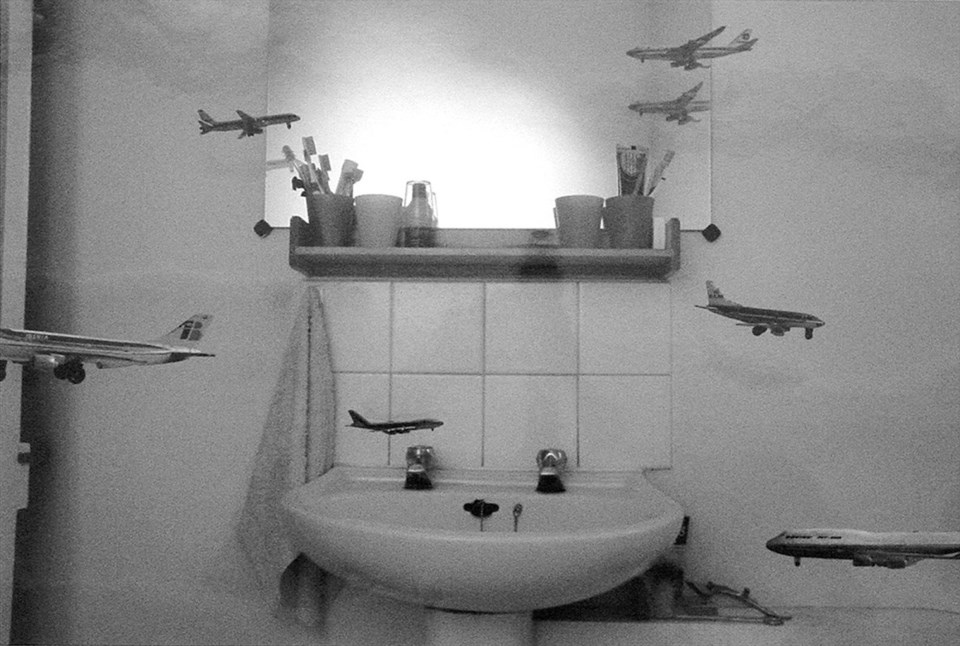 Lineaments, the major video of the current show by Hiraki Sawa, is projected in the gallery on contiguous walls which join at the corner. It is in black and white. I found a bench on the far side of the room and sat down to take in the experience:
Lineaments, the major video of the current show by Hiraki Sawa, is projected in the gallery on contiguous walls which join at the corner. It is in black and white. I found a bench on the far side of the room and sat down to take in the experience:
Black and white bathroom tiles, feet on the floor, ants running by. Iron threads extrude from holes in a stucco wall. A young man in a white shirt is seen from the back, his head going from side to side like a metronome. A phono disc goes around on a player, and the grooves of the disc are seen in closeup. They unwind as they go, as if made of wire.
A table lamp nods its head knowingly. The young man — maybe Buster Keaton’s little brother — appears and disappears in this airless environment, which recalls a set from a Guy Madden film or a book by Kafka. The wire continues to extrude, like hair growing, projecting under the door. Many wires, in parallel, vibrate as if in the wind. A tiny gear spins on a table, and spins on, reluctant to stop.
Springs uncoil in concentric circles. A clockwork with no dial hangs on the wall. Then it lies on the floor with a huge key sticking up from it. I am reminded of the stop-action animated films of Jan Svankmeier.
Waves wash by silently outside a dirty window. A chandelier is seen from below, and then the whole room is upside down with the chandelier coming up from the floor. The man is now hanging down. A metronome silently ticks. The man presses a phonograph disc to his ear, as if to hear, and beside him his duplicate sits at a desk.
The camera slowly pans by a radiator. Stones line up on the window sill. Books occupy a shelf. The drain hole centres the sink, and the sink rotates. As the soundtrack keens like an unearthly violin, two phono discs appear, superimposed. A gear floats in space. The young man’s head dims. The screens go blank.
(The pamphlet that accompanies this show explains that Lineament features a protagonist who suffers from amnesia, and the images “communicate ideas of both the collapsing of time and its measured passage.”)
The little gallery next door is given over to Envelope, a video in which a dark woman in a floor-length cotton dress slowly dances in a vacant room. She divides in two, in bilateral symmetry, and plays with her index fingers. She lights a candle and her doppelganger blows it out. She relights it.
She places a white china bowl on the floor before her and crushes it beneath her feet. A light bulb of complex filament sways overhead, and — emerging at last in rich colour — the woman assembles flowers in kaleidoscopic display. When seen in reflected in a mirror across the room, the video appears to take place in an endless corridor. The sounds of a music box tinkle throughout.
One of the six video displays in another gallery presents a small apartment, as you might find in a big city anywhere. Surprisingly, little aircraft fly by. From stage left, from stage right, through the open door at the back, they hover heavily, like jumbo jets slowly achieving liftoff. They pass one another in a torpid way, in the way that aircraft appear as they approach or depart from airports. There is no narrative or drama to these toy-like arrivals and departures.
The Art Gallery of Greater Victoria has given over its two largest rooms, and a smaller one, to an exhibition of videos by Hiraki Sawa, who was born Japan in 1977, and lives in London. Each video has a novel projection or display monitor — perhaps three screens stacked vertically, or one set in a tiny eye-piece. Otherwise, this exhibition could be watched on your iPhone.
But video in a gallery is what it is. It might demand a huge empty room all to itself, where the flickering screens speak to themselves, mostly in the dark. Video demands that you spend some time. Lineaments, one of 16 installations, takes more than 18 minutes to absorb; Envelope is 11 minutes and 20 seconds. I gave this show an hour and a half and even then I wasn’t able to watch it all. I stayed on out of a sense of duty.
This exhibition, Under the Box, Beyond the Bounds, was first presented at the Tokyo Opera City Gallery this year. Victoria is the only place in Canada where this advanced and admired work is being presented. As art-video installations go, this is top-flight stuff. Sawa has had solo shows at the Hirshhorn Museum in Washington, National Gallery of Victoria, Melbourne, the Hiroshima City Museum of Contemporary Art and many others.
A master of his chosen medium, Sawa addresses the big themes, such as time and memory and our modern dislocation from one another. He does it in the modern way: non-linear and inconclusive. His visual poetry resonates and echoes in your head, if you have an open mind.
The images I took away include a young man holding a phono disc to his head as if he might hear something; a little video screen showing empty rooms where rocking horses silently rock; a full moon patiently drawn and then erased.
And finally, I recall the vast gallery in semi-darkness, the video projection playing on and on, reflecting in the shiny floor. And nobody there.
Hiraki Sawa: Under the Box, Beyond the Bounds, at the Art Gallery of Greater Victoria, 1040 Moss St., aggv.ca, 250-384-4171, until Jan. 11.
